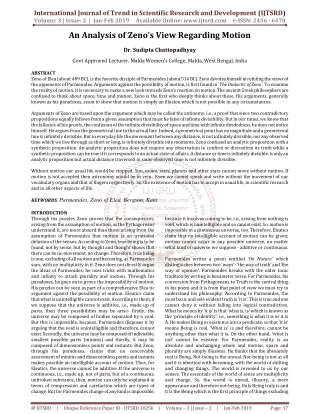An Analysis of Zeno's View Regarding Motion
Zeno of Elea about 489 BC , is the favorite disciple of Parmenides about 514 BC . Zeno devotes himself in refuting the views of the opponents of Parmenides. Arguments against the possibility of motion, is first found in The Dialectic of Zeno. To examine the reality of motion, it is necessary to make a new look towards Zeno's reaction on motion. The ancient Greek philosophers are confused to think about space, time and motion. Zeno is the first who deeply thinks about these. His arguments, generally known as his paradoxes, seem to show that motion is simply an illusion which is not possible in any circumstances. Arguments of Zeno are based upon the argument which may be called the antinomy, i.e., a proof that since two contradictory propositions equally follows from a given assumption that must be false of infinite divisibility. But in our times, we know that the fallacies of his proofs, the confusion of the infinite divisibility of space and time with infinite dividedness, he does not notice himself. He argues from the geometrical line to the actual line. Indeed, a geometrical point has no magnitude and a geometrical line is infinitely divisible. But in everyday life the movement between any distance, is not infinitely divisible, nor any observed time which we live through as short or long, is infinitely divisible into moments. Zeno confused an analytic proposition with a synthetic proposition. An analytic proposition does not require any observation to confirm or disconfirm its truth while a synthetic proposition can be true if it corresponds to an actual state of affairs. A distance or time is infinitely divisible, is only an analytic proposition but actual distance traversed in same observed time is not infinitely divisible. Without motion our usual life would be stopped. Sun, moon, stars, planets and other stars cannot move without motion. If motion is not accepted then astronomy would be in vein. Even we cannot speak and write without the movement of our vocabulary organs and that of fingers respectively. So, the existence of motion has to accept in usual life, in scientific research and in all other aspects of life. Dr. Sudipta Chattopadhyay "An Analysis of Zeno's View Regarding Motion" Published in International Journal of Trend in Scientific Research and Development (ijtsrd), ISSN: 2456-6470, Volume-3 | Issue-2 , February 2019, URL: https://www.ijtsrd.com/papers/ijtsrd20256.pdf Paper URL: https://www.ijtsrd.com/humanities-and-the-arts/philosophy/20256/an-analysis-of-zenou2019s-view-regarding-motion/dr-sudipta-chattopadhyay
★
★
★
★
★
65 views • 5 slides

